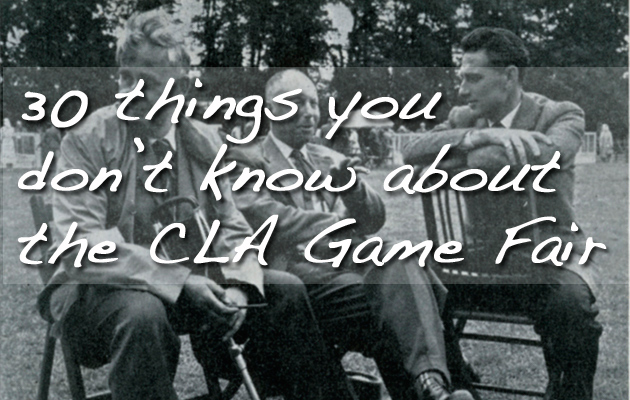30 things you don’t know about the CLA Game Fair
As the CLA Game Fair approaches its 56th year, we bring you 30 facts that you probably don't know about the biggest country sport event

The early days
- The first CLA Game Fair at Stetchworth Park was put on with a budget of just £500, but it overran by £300.
- Entrance charges at the first fair were modest; two shillings and sixpence per person admission (half-price to children, free to CLA members), 5/6 (271⁄2p) for cars and 2/6 (121⁄2p) for motorcycles. Bicycles were free.
- There were 55 exhibitors at the first fair — the modern fair can feature up to 1,000 exhibitors.
- The total attendance at the first fair was reported as 8,500 — 17 times the 1958 Game Fair committee’s cautious original estimate.
- Fisherman’s Row did not feature at the Game Fair until the second show at Hackwood Park, in 1959. It was the only time the Game Fair has ever used an artificially dug pond — every year since, existing lakes and rivers have been used.
- Long-service medals were first awarded to gamekeepers at the Longleat fair in 1962.
- The first person to fly in was the Duke of Gloucester, the fair’s chairman, who flew in to Hackwood Park in 1959.
Places & people
- In 1976, the Game Fair went to Wales for the first time, to Glanusk Park, Powys. HRH Prince Charles was the fair’s new patron (following the death of the Duke of Gloucester in 1974).
- The first CLA Game Fair to be held in Scotland was at Blair Drummond, near Stirling, in 1964. It was organised and run by the Scottish Landowners’ Federation — and was unfortunately the first occasion when attendance fell year-on-year (to 19,000 from 30,000 the previous year).
- The first fair to suffer from serious traffic problems was held at Shotover, near Oxford, in 1965 — it hosted a record-breaking 41,000 people.
- HM The Queen (right) first attended a Game Fair in 1974, at Stratfield Saye, Berkshire — the same year that the Pugs and Drummers stand made its first appearance.
- Chatsworth was the first venue to be used more than once — the first time in 1966, followed by a repeat visit nearly a decade later in 1975.
A date to remember
- The CLA has done much to educate people about the dangerof leaving overheating dogs in cars — in 1999, 50 dogs a day were removed from cars at the Game Fair. In 2006 that figure was down to just one.
- In 2001, when the Game Fair was resited from Woburn Abbey to Shuttleworth Park due to foot- and-mouth, the fair’s organisers were forced to buy fields of standing corn and cut it green in order to accommodate car parking.
- Attendance reached a record of 138,000 people at the 2006 fair, held at Broadlands.
- The cost of cancelling the 2007 fair due to severe rainfall at Harewood House was put at £50million — £12million inside the show and £38million in the surrounding region.
- In 1979, at Bowood, in Wiltshire, the Game Fair became a three-day event for the first time. Previously, the show had only been run on Friday and Saturday.
- Attendance first passed the magic 100,000 figure at Bowood in 1979 — in fact, it smashed the barrier and went on to 113,000 people.
Size matters
- Due in part to the size of the infrastructure now required, Belvoir Castle, Blenheim, Harewood and Broadlands have been fixed as the four rotating Game Fair venues.
- More than 23,000 vehicles come and go to the Game Fair showground each day — the CLA uses its own helicopter to monitor traffic flow.
- The CLA owns storage tanks capable of holding 47,000 gallons of water and storing a similar amount of wet waste.
Hard work
- More than 60 staff are employed on the clay lines, operating 120 traps.
- The organisers usually remove about one mile of post and rail fence and put in four miles of temporary fencing.
- At Blenheim, approximately 1.5 miles of pipework will be installed for water and telecommunications — but there is already 3.5 miles of pipework underground which was put in when the fair was previously held there.
The numbers
- Roughly 140 tonnes of rubbish is created over the three days — this year, cardboard and glass recycling facilities will be on site.
- Four miles of tentage are ordered by the organisers for exhibitors — that does not include tentage that exhibitors order on their own behalf.
- The fair has a full-time team of 22 organisers and there will be 400 or so temporary contractors on site in July — they will work approximately 18,480 hours.
- During the three days of the modern Game Fair, 13,000 glasses of Pimm’s and 86,000 cups of coffee are dispensed by the caterers in the CLA Members’ Enclosure alone. In addition, the best parts of 340 pigs and nearly a tonne of smoked salmon are served.
- 60,000 or so gallons of beer, lager and cider are drunk at the fair.
- The electrical supply to the fair requires 55 generators and 18 miles of cables, sufficient to run a small town. They will use more than 70,000 litres of diesel.








